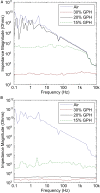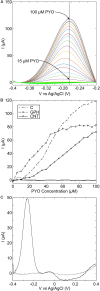Toward a Closed Loop, Integrated Biocompatible Biopolymer Wound Dressing Patch for Detection and Prevention of Chronic Wound Infections
- PMID: 32984295
- PMCID: PMC7493637
- DOI: 10.3389/fbioe.2020.01039
Toward a Closed Loop, Integrated Biocompatible Biopolymer Wound Dressing Patch for Detection and Prevention of Chronic Wound Infections
Abstract
Chronic wound infections represent a significant burden to healthcare providers globally. Often, chronic wound healing is impeded by the presence of infection within the wound or wound bed. This can result in an increased healing time, healthcare cost and poor patient outcomes. Thus, there is a need for dressings that help the wound heal, in combination with early detection of wound infections to support prompt treatment. In this study, we demonstrate a novel, biocompatible wound dressing material, based on Polyhydroxyalkanoates, doped with graphene platelets, which can be used as an electrochemical sensing substrate for the detection of a common wound pathogen, Pseudomonas aeruginosa. Through the detection of the redox active secondary metabolite, pyocyanin, we demonstrate that a dressing can be produced that will detect the presence of pyocyanin across clinically relevant concentrations. Furthermore, we show that this sensor can be used to identify the presence of pyocyanin in a culture of P. aeruginosa. Overall, the sensor substrate presented in this paper represents the first step toward a new dressing with the capacity to promote wound healing, detect the presence of infection and release antimicrobial drugs, on demand, to optimized healing.
Keywords: Polyhydroxyalkanoates; Pseudomonas aeruginosa; artificial intelligence; biopolymer; electrochemical; graphene; pyocyanin; wound dressing.
Copyright © 2020 Ward, Dubey, Basnett, Lika, Newman, Corrigan, Russell, Kim, Chakrabarty, Connolly and Roy.
Figures







Similar articles
-
Impact of a novel, antimicrobial dressing on in vivo, Pseudomonas aeruginosa wound biofilm: quantitative comparative analysis using a rabbit ear model.Wound Repair Regen. 2014 Nov-Dec;22(6):712-9. doi: 10.1111/wrr.12232. Epub 2015 Jan 8. Wound Repair Regen. 2014. PMID: 25230854
-
Electrochemical Detection of Multianalyte Biomarkers in Wound Healing Efficacy.ACS Sens. 2020 Nov 25;5(11):3547-3557. doi: 10.1021/acssensors.0c01697. Epub 2020 Nov 11. ACS Sens. 2020. PMID: 33175510
-
Choosing a Wound Dressing Based on Common Wound Characteristics.Adv Wound Care (New Rochelle). 2016 Jan 1;5(1):32-41. doi: 10.1089/wound.2014.0586. Adv Wound Care (New Rochelle). 2016. PMID: 26858913 Free PMC article. Review.
-
Clinical and in vitro performance of an antibiofilm Hydrofiber wound dressing.J Wound Care. 2018 Sep 2;27(9):584-592. doi: 10.12968/jowc.2018.27.9.584. J Wound Care. 2018. PMID: 30204577
-
Ovine-Based Collagen Matrix Dressing: Next-Generation Collagen Dressing for Wound Care.Adv Wound Care (New Rochelle). 2016 Jan 1;5(1):1-10. doi: 10.1089/wound.2015.0660. Adv Wound Care (New Rochelle). 2016. PMID: 26858910 Free PMC article. Review.
Cited by
-
The Influence of Novel, Biocompatible, and Bioresorbable Poly(3-hydroxyoctanoate) Dressings on Wound Healing in Mice.Int J Mol Sci. 2022 Dec 18;23(24):16159. doi: 10.3390/ijms232416159. Int J Mol Sci. 2022. PMID: 36555799 Free PMC article.
-
Wearable Bioelectronics for Chronic Wound Management.Adv Funct Mater. 2022 Apr 25;32(17):2111022. doi: 10.1002/adfm.202111022. Epub 2021 Dec 26. Adv Funct Mater. 2022. PMID: 36186921 Free PMC article.
References
-
- Barbuti R., Caravagna G., Maggiolo-Schettini A., Milazzo P., Pardini G. (2008). “The calculus of looping sequences,” in Formal Methods for Computational Systems Biology, eds Bernardo M., Degano P., Zavattaro G. (Berlin: Springer; ), 387–423. 10.1007/978-3-540-68894-5_11 - DOI
-
- Basnett P., Lukasiewicz B., Marcello E., Gura H. K., Knowles J. C., Roy I. (2017). Production of a novel medium chain length poly(3-hydroxyalkanoate) using unprocessed biodiesel waste and its evaluation as a tissue engineering scaffold. Microb. Biotechnol. 10 1384–1399. 10.1111/1751-7915.12782 - DOI - PMC - PubMed
-
- Basnett P., Marcello E., Lukasiewicz B., Panchal B., Nigmatullin R., Knowles J. C., et al. (2018). Biosynthesis and characterization of a novel, biocompatible medium chain length polyhydroxyalkanoate by Pseudomonas mendocina CH50 using coconut oil as the carbon source. J. Mater. Sci. Mater. Med. 29:179. 10.1007/s10856-018-6183-9 - DOI - PubMed
LinkOut - more resources
Full Text Sources
Other Literature Sources
Molecular Biology Databases

